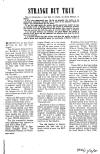Home Page Meet Boston Menu Index
|
STRANGE
BUT TRUE Friday, January 3, 1941 in What's New In Town W. J. Sidis |

STRANGE BUT TRUE
|
This is introducing a new kind of column, by Jacob Marmor, to Boston. It is a very impersonal one. As far as possible, the author is an impersonal character, injecting into it none of his personal ideas or habits: and personalities do not enter. To get the right spirit, the reader should regard the author as just an old-time lover of Boston, who, in the course of wandering around, has picked up scraps of information and stories. Not a native, but one who can see the city with the eyes of a lover rather than a relative. It is not pure history, nor memory, nor pure fiction, but rather a mixture of all three: not dry research, but affection that puts life-blood into the material. It is merely hoped that this column will give the reader an idea of what a great and wonderful place our metropolis of Boston really is. |
Boston has as big buildings as any city anywhere . . .
The Christian Science Monitor Building, if stood on its front end, would show about the same dimensions as New York’s Woolworth Building . . .
The M.I.T. Building in Cambridge could hold about three Empire State Buildings lying on their side, with room to spare . . .
The Park Square Building has about the same volume as the Chrysler . . .
South Station is larger than New York’s Grand Central . . .
While Manhattan Island, if it could be folded in two like a jacknife, could find room in the less settled reaches of West Roxbury . . . Boston is the largest city on this continent to serve as a seat of government . . .
There are 995 streets on Manhattan Island. There are 997 streets in Dorchester alone . . . It has more people per square mile than any other state except Rhode Island and New Jersey. According to the census of 1930, Somerville had more people per square mile than any other American city of over 100,000 population.
*
The first vaudeville theater ever operated was opened in Boston in May, 1881, by Benjamin Franklin Keith. The Normandie Theater, on Washington Street, is in the same building, and in its entrance can still be seen some of the old-time decorations―including the fireplaces―used for the original theater sixty years ago. The annex, now used as a Tremont Street entrance to the new Keith Memorial Theater, was used as a Tremont Street entrance to the old vaudeville house―via a tunnel, now unused, but both ends of which can still be seen; one end is in the Normandie, and still carries the sign “Exit to Tremont St.”, while the other end is in the Tremont Street entrance building, in the form of a stairway blocked by a gate, through which can still be seen the mirrors, furniture, and fireplaces that decorated the tunnel in the old days.
At this theater were shown the first talking pictures, made by Edison way back in 1911, and called by him the “Kinetophone.”
At present a door on Mason Street, unused for years, bears the mysterious words NOW NOW. It is an entrance to this original vaudeville building, and formerly under the “nows” were posted announcements of the current attractions in the theater.
The old theater in Boston became the first unit of a chain which is now the RKO system.
*
Brookline, like ancient Rome, is built on seven hills―Corey, Aspinwall, Fisher, Babcock, Walnut, Single Tree, and the Uplands. These hills are formed of material brought down from the White Mountains by the glaciers of the Ice Age, and molded to their present oval shape by the ice itself.
Corey Hill is the best place to get a good view of Greater Boston―at least a panoramic view of it. Visitors may reach it by the Reservoir car (which can be taken in the Tremont or Boylston Street subways), to “Summit Path,” an interesting little stairway leading up the hill, a sort of stairway very common for the hills of Brookline. Auto drivers may drive out Beacon Street, and turn right on to Summit Avenue, three blocks beyond Coolidge Corner. At the top of the hill is a small park, which is an excellent place from which to see the view. The hillside was one of the hideouts from which Brookline minutemen took potshots at the retreating redcoats after the battle of Concord, (the Britishers passed by on Harvard Street, below the hill); while the hilltop was rebel headquarters from that time till the coming of General Washington in July of 1775, (at least, so marked on some British military maps brought by Lord Howe to New York,
[Continuation missing from the compilation in Helena Sidis’s suitcase.]